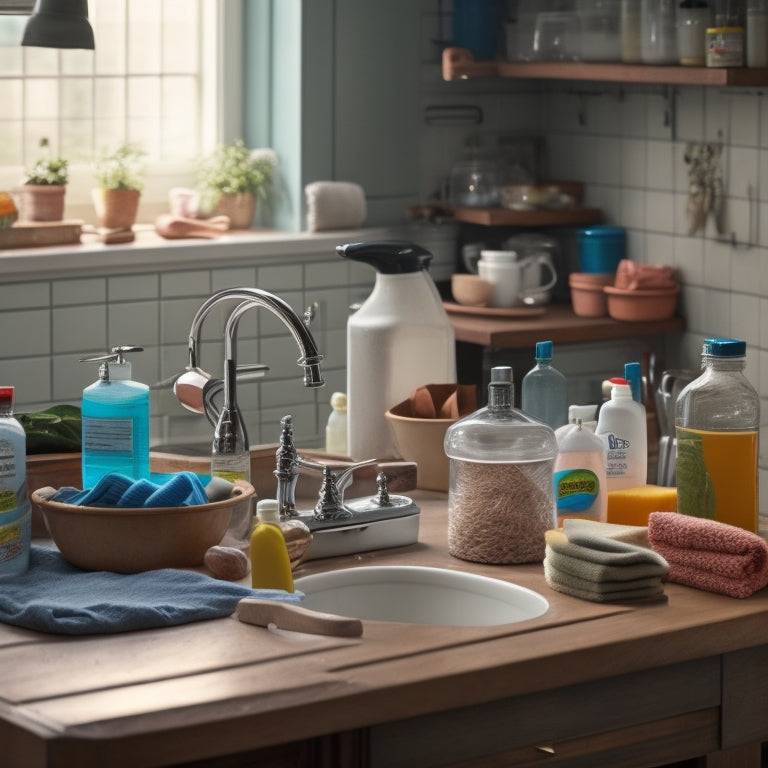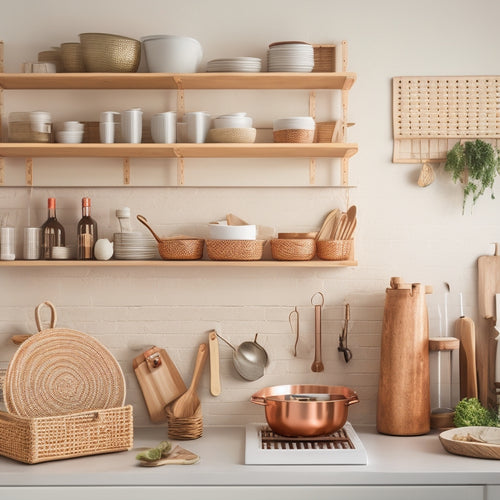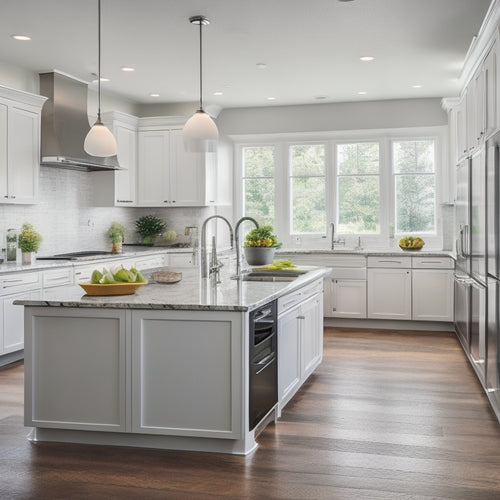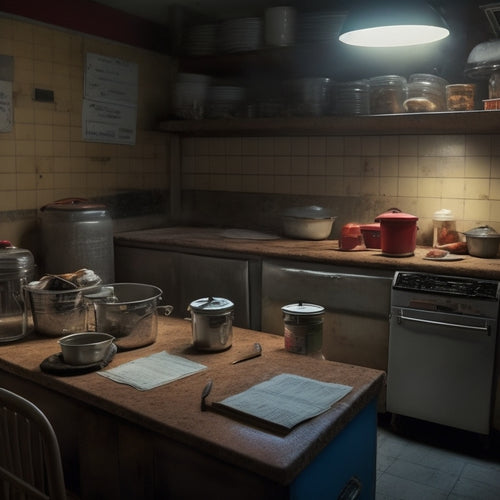
Create a DIY Sink Organizer for Your Kitchen Desk
Share
You'll start by measuring your kitchen desk space, taking note of the sink dimensions, surrounding cabinets, and obstructions like pipes or outlets. Then, choose materials and tools that fit your style and budget, considering modern options or repurposed materials. Next, design a layout that works with your space constraints, prioritizing easy accessibility and workflow. Assemble your organizer components, focusing on stability and support, and install it securely in your designated spot. With these basics covered, you'll be ready to add the finishing touches and clever hacks that'll make your DIY sink organizer truly shine - and that's just the beginning of your kitchen desk transformation.
Key Takeaways
• Measure your kitchen desk space, considering sink dimensions, surrounding cabinets, and obstructions to determine the ideal organizer size and layout.
• Choose materials and tools that fit your style and budget, such as modern options like stainless steel or reclaimed wood, or repurposed materials like pallets or crates.
• Design a layout that visualizes the space constraints, ensuring easy accessibility and workflow, and categorizes items like soap and sponges efficiently.
• Assemble the organizer components, following the design plan, and ensuring each piece fits snugly, with a focus on stability and support of the base.
• Install and customize the organizer, placing it securely, adding dividers or baskets, and incorporating clever hacks like adhesive magnets or repurposed items to maximize storage and functionality.
Measure Your Kitchen Desk Space
Before you begin designing your DIY sink organizer, measure your kitchen desk space carefully to guarantee a seamless fit, taking into account the dimensions of the sink, surrounding cabinets, and any obstructions. This vital step will save you from potential measurement mistakes that can ruin the entire project. Take note of the sink's width, length, and depth, as well as the distance between the sink and the surrounding cabinets. Don't forget to take into account any obstructions, such as pipes or electrical outlets, that may impact the design of your organizer.
A well-measured space ensures that your DIY sink organizer complements your desk aesthetics, creating a harmonious and functional workspace. Measure the space where you plan to install the organizer, taking into account the height, width, and depth of the area. This will help you design an organizer that fits perfectly, providing ample storage and counter space.
Choose Materials and Tools Needed
With your kitchen desk space accurately measured, you can now select the perfect materials and tools to bring your DIY sink organizer to life. Consider the style and functionality you want to achieve, and choose materials that fit your vision. For a modern look, opt for sleek and durable materials like stainless steel or reclaimed wood. If you're on a budget, repurposed materials like old pallets or crates can be a cost-effective option.
Here's a breakdown of the estimated material costs and tools you'll need:
| Material/Tool | Cost | Storage Needed |
|---|---|---|
| Wood (e.g., pallets or crates) | $0 - $20 | Small |
| Stainless steel sheets | $50 - $100 | Medium |
| Drill and bits | $20 - $50 | Tool storage |
| Screws and glue | $10 - $20 | Tool storage |
Remember to factor in the cost of any additional materials, such as paint or stain, and consider the space you have available for tool storage. By choosing the right materials and tools, you'll be well on your way to creating a functional and stylish DIY sink organizer that fits your kitchen desk space and budget.
Design Your Sink Organizer Layout
Now that you've selected your materials and tools, it's time to visualize your sink organizer's layout, taking into account the space constraints of your kitchen desk and the items you want to store.
This is where you get to think creatively and strategically about how you want to utilize the space. Start by measuring your kitchen desk and identifying the areas where you want to place your sink organizer.
Consider the best placement of your organizer, ensuring it's easily accessible and doesn't obstruct your workflow. Think about the items you want to store, such as soap, sponges, and scrubbers, and how you can categorize and group them for efficient use.
Balance functionality with aesthetic appeal by selecting a layout that complements your kitchen's style. Aim for aesthetic balance by distributing the weight and visual interest of your organizer evenly.
Assemble the Organizer Components
You're ready to bring your design to life by assembling the individual components of your sink organizer, carefully following the plan you've created to guarantee a functional and stylish addition to your kitchen desk. This is the exciting part where your vision takes shape, and you get to see the fruits of your labor.
As you start assembling, keep in mind the corner constraints you identified during the design phase. You'll want to make sure that each component fits snugly and efficiently, without compromising the overall aesthetic. Consider the shelf styles you've chosen, and how they'll work together to create a harmonious and functional space.
Here are a few key elements to focus on as you assemble:
-
The base of your organizer, which will provide stability and support for the entire structure
-
The shelves and compartments, which will help keep your sink area organized and clutter-free
-
The decorative trim and finishes, which will add a touch of personality and style to your design
Install and Customize Your Organizer
Place your assembled organizer in its designated spot on your kitchen desk, ensuring a secure fit that complements the surrounding space. Double-check that it's level and even, making any necessary adjustments.
Now, it's time to customize your organizer to fit your specific needs. Start by adding dividers or baskets to separate utensils, cleaning supplies, or other kitchen essentials. Consider adding a small tray or dish for corralling small items like rings or earrings. For a personal touch, attach a few decorative hooks for hanging tea towels or aprons.
To take your organizer to the next level, incorporate some clever hacks. For example, use adhesive magnets to attach a small spice rack or a strip of hooks for hanging frequently used items. You can also repurpose an old mason jar as a utensil holder or add a small chalkboard for jotting down grocery lists.
With these customization tips, you'll create an organizer that not only keeps your kitchen tidy but also reflects your personal style.
Frequently Asked Questions
Can I Use a DIY Sink Organizer in a Bathroom or Laundry Room?
You can definitely repurpose a DIY sink organizer in a bathroom for Bathroom Essentials like toiletries or in a laundry room for Laundry Necessities like detergent and fabric softener, maximizing storage and keeping clutter at bay.
How Do I Clean and Maintain My DIY Sink Organizer?
You'll want to incorporate daily routines to clean your DIY sink organizer, wiping down surfaces after each use and tackling soap scum buildup weekly to keep it looking its best and functioning smoothly.
Are DIY Sink Organizers Suitable for Small or Irregularly Shaped Sinks?
"Did you know 75% of homeowners struggle with sink clutter? You'll be relieved to know DIY sink organizers can adapt to small or irregularly shaped sinks by considering sink measurements and corner adaptability, ensuring a perfect fit for your unique space."
Can I Add a Garbage Disposal or Water Filter to My DIY Organizer?
You can definitely add a garbage disposal or water filter to your DIY organizer! Consider Disposal Placement near the drain, and Filter Integration under the sink or on the countertop for seamless functionality.
Will a DIY Sink Organizer Affect My Kitchen's Resale Value?
You're wise to take into account resale concerns - a thoughtfully designed DIY sink organizer can actually boost your kitchen's appeal, as it showcases your attention to detail and commitment to functional design, ultimately enhancing its resale value.
Related Posts
-

Revolutionize Your Kitchen Storage With These Ideas
You're ready to revolutionize your kitchen storage! Start by incorporating ladder-accessible shelves and utilizing cl...
-

5 U-Shaped Kitchen Layout Ideas to Revamp Your Space
You're about to reveal the secret to a kitchen that's both stunning and supremely functional, where every inch of spa...
-

Food Safety Inspections Uncover Startling Violations
Food safety inspections in local establishments have uncovered a disturbingly high number of critical violations, put...


